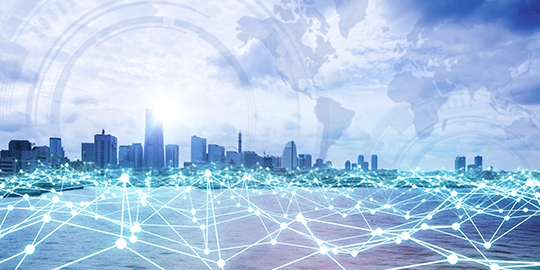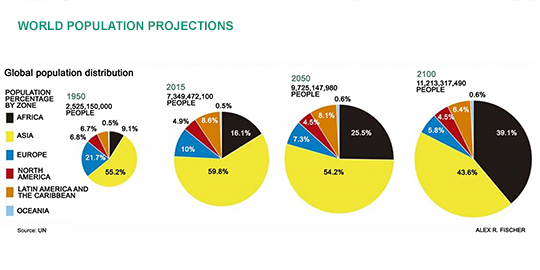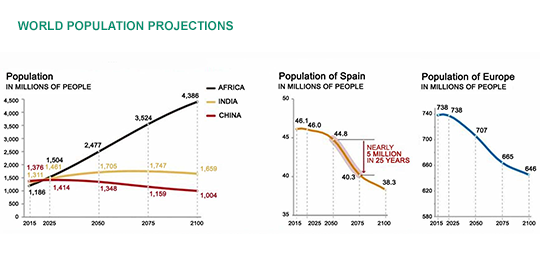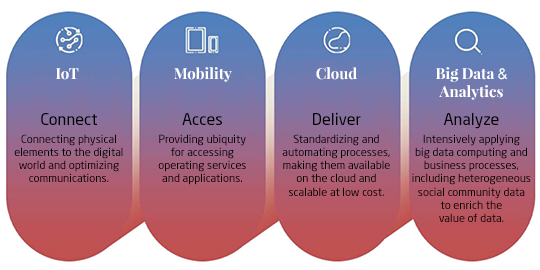
Justin Bieber, Smart Water & Cybersecurity
Justin Bieber is only 23 years old, yet during his lifetime "humanity has burned up 41% of all the fossil fuels consumed in the planet's history”. With such discouraging news, it is no doubt necessary to take action against climate change and attempt to mitigate its effects before 2050.
The effects of climate change, population growth, concentration of populations in cities, and water requirements for food caused by changes in eating habits, flooding, droughts, storms and other climate-related natural disasters are an explosive cocktail that will affect our lives and the availability of natural resources, including water.
The UN's most recent world population projection report considers that it is "nearly inevitable" that the number of inhabitants on the planet will continue growing.
According to calculations, the current world population of 7.3 billion will surge to 8.5 billion by 2030 and 9.7 by 2050, and the African continent will be responsible for over half of this population growth, reaching 25% of the total population by 2050.
Growth continues being "especially elevated" in the group of 48 countries designated by the UN as the least developed in the world, of which 27 are in Africa. The population of these poorest nations will double in the next 15 years and again by 2050, reaching nearly 2 billion people. As we approach 2100, the population of 10 African countries will have increased by at least fivefold.


The population increase will join a higher population concentration in cities, as over 6.3 billion people are expected to be living in cities by 2050.
THE WATER CHALLENGE
This means generating enough food for a growing population that will have exceeded 9 billion people by 2050, a challenge in terms of water, since food production currently consumes 70% of the water resources used worldwide, e.g., it takes over 450 litres of water to produce one single egg if we include all the processes carried out before the egg reaches our kitchen table.
If we were to also consider the ever more frequent droughts and flooding and an increasing desertification process —at a rate of 12 million hectares every year—, how can we meet the water challenges in the next 15 years?
A study of the Organization for Economic Co-operation and Development (OECD) projects that the world's thirst for water will increase by 55% between 2000 and 2050. By then the Environmental Outlook 2050 calculates that over 40% of the world's population will not have enough.
Even so, the World Bank estimates that we are losing 50 billion cubic meters of water every year because of leaks and bursts in the drinking water supply network.
650 main water lines break every day in America at a rate of one every two minutes. According to the USGS (US Geological Survey), these breaks and other filtrations result in the loss of approximately 1.7 billion gallons of water every year, enough to provide water to 68 million Americans.
TECHNOLOGY AS THE NEW DRIVER OF EFFICIENCY
For a long time in the field of development, the solution to water supply problems has been polarized exclusively in the construction of infrastructure. The approach toward increasing access to water and plumbing intensified the attention on the construction of aqueducts, canals, wells and other improved clean water systems, moving billions of dollars from bilateral and multilateral initiatives and development banks in the past decade. This has had a very positive effect on improving the world's situation. However, experience has also shown that construction work alone will not always solve the problem.
In recent years, developments in technology have assumed a central role in the efficient management of this precious and limited resource, with the appearance of projects in this regard.

We are immersed in an unprecedented technological paradigm shift in our history and the water sector is not immune to its impact. Concepts such as big data, the Internet of Things (IoT) and augmented reality are already transforming traditional business and opening up new fields of business and specialization for companies and professionals.
SMART WATER
Smart water management solutions (Smart Water), similar and complementary to energy generation, distribution and consumption management (Smart Grid and Smart Metering), has a broad range of applications.
These Smart Water solutions allow us to optimize water resource management through the use of key components such as: Sensors, Communications, IoT PlatformThese solutions help water utilities be more efficient and make more informed decisions, using IoT, artificial intelligence, big data, mobility solutions, etc.
In light of the growing volumes of information, entities are dedicating an increasing amount of resources to forestall potential risks and benefit from emerging opportunities.
With technology playing an ever greater role in managing such a critical resource, the concern swings back to the question of how secure we are.
SMART WATER AND SECURITY
Raids on water systems have been well known since 300 b.C., when the Greek army was reported to have left animal corpses in enemy wells. Water poisoning was also a common practice during the Napoleonic Wars and episodes of the Second World War, when the Japanese contaminated food and water sources with different biological agents such as Bacillus anthracis, Vibrio cholera, Shigella spp, Salmonella spp and Yersinia pestis. During the Vietnam War, a common action of war involved contaminating water supply points using bamboo stalks infected with biological agents.
The investigations immediately following the 9/11 attacks in 2001 also uncovered a possible wave of terrorism planned for the 22 September in the same year that would have poisoned the drinking water.
Faced with such a scenario, which considerably raises the awareness of public opinion and the organizations responsible for protecting our health, a shared opinion is that the real risk of generalized terrorism attacks on water systems is reasonably limited.
In light of the foregoing considerations, we should bear the changing scenario in mind in that the introduction of IoT technology in the processes of water utilities raises the likelihood that most threats will concern attacks on the objects installed in the network.
It is therefore essential that we guarantee the appropriate measures to prevent and address the risk of criminal attacks on water systems, particularly from organizations that have the knowledge necessary to overcome the difficulties that implementing such an attack would entail.
Water is a critical resource and, as a fundamental right, should reach every home. Yet, an accident involving this resource would cause a condition where we would feel safer "at home", resulting in a more widespread feeling of insecurity in the population. The main effects of an attack against water infrastructures could entail a water supply shutdown, resource contamination (more dangerous yet less likely) and situations against third parties because of the improper management of flooding or untreated wastewater dumping into vulnerable ecosystems.
A worst-case scenario could be the intentional contamination of a system, directly threatening an entire city. It would lead to an immediate shutdown of water supply in that city, followed by the distribution of water by water tankers for at least a week (being optimists) and the international press looking for the spin.
From this point of view, the most vulnerable element of a drinking water supply system would have been attacked. People´s confidence in the supply system.
A population's trust is intangible and extremely fragile. It can be lost in a blink of an eye but only recovered after an enormous amount of time and effort. This trust is so crucial that a single breach could become an open wound that never heals. Let's imagine the following: let's say somebody simulates a threat in our city, claiming to have poured a contaminating substance in the water mains, would we use water from the network to cook or bathe our children? How much effort would the water utility need to convince us that water is safe again?
Despite not appearing on the main stream media, a number of terrorist attacks on water infrastructures have been confirmed in Italy, the Middle East, China and even the USA. In fact, the US EPA (Environmental Protection Agency) and the Department of Homeland Security are working together to build a water safety test bench.
This rising use of sensors and the exponential increase of information on Operation Technologies (OT) are vulnerable to possible malicious attacks, terrorism, vandalism, hackers, etc.
These risks facing IT, and especially OT in each critical process of the water cycle, should be addressed with cybersecurity criteria in both fields.
The objective of direct attacks is to access the IoT device and, by extension, the sensors, machines and environments to which the device is connected. As such, this type has the potential of being even more damaging and destructive. Criminals, terrorists and malicious foreign governments could use connected devices to cause havoc and losses, e.g., pirating a security system to rob, hijack or kidnap someone, or taking command of a city by controlling its water system. In theory, this should be a sufficient motivation to secure such devices. However, the frequent lack of resources or attention to details, even for assets of high value, have resulted in an increase in cybernetic attacks.

Add new comment